#indo european mythology
Text
Blackcrowing's Master Reading List

I have created a dropbox with pdfs I have gathered over the years, I have done my best to only allow access to documents which I found openly available through sites like JSTOR, Archive.org, or other educational resources with papers available for download.
That being said I ALSO recommend (I obviously have not read all of these but they are either in my library or I intend to add them)
📚 Celtic/Irish Pagan Books
The Morrighan: Meeting the Great Queens, Morgan Daimler
Raven Goddess: Going Deeper with the Morríghan, Morgan Daimler
Ogam: Weaving Word Wisdom, Erynn Rowan Laurie
Irish Paganism: Reconstructing Irish Polytheism, Morgan Daimler
Celtic Cosmology and the Otherworld: Myths, Orgins, Sovereignty and Liminality, Sharon Paice MacLeod
Celtic Myth and Religion, Sharon Paice MacLeod
A Guide to Ogam Divination, Marissa Hegarty (I'm leaving this on my list because I want to support independent authors. However, if you have already read Weaving Word Wisdom this book is unlikely to further enhance your understanding of ogam in a divination capacity)
The Book of the Great Queen, Morpheus Ravenna
Litany of The Morrígna, Morpheus Ravenna
Celtic Visions, Caitlín Matthews
Harp, Club & Calderon, Edited by Lora O'Brien and Morpheus Ravenna
Celtic Cosmology: Perspectives from Ireland and Scotland, Edited by Jacqueline Borsje and others
Polytheistic Monasticism: Voices from Pagan Cloisters, Edited by Janet Munin
📚 Celtic/Irish Academic Books
Early Medieval Ireland 400-1200, Dáibhí Ó Cróinín
The Sacred Isle, Dáithi Ó hÓgáin
The Ancient Celts, Berry Cunliffe
The Celtic World, Berry Cunliffe
Irish Kingship and Seccession, Bart Jaski
Early Irish Farming, Fergus Kelly
Studies in Irish Mythology, Grigory Bondarnko
Prehistoric Archaeology of Ireland, John Waddell
Archeology and Celtic Myth, John Waddell
Understanding the Celtic Religion: Revisiting the Past, Edited by Katja Ritari and Alexandria Bergholm
A Guide to Ogam, Damian McManus
Cesar's Druids: an Ancient Priesthood, Miranda Aldhouse Green
Animals in Celtic Life and Myth, Miranda Aldhouse Green
The Gods of the Celts, Miranda Green
The Celtic World, Edited by Miranda J Green
Myth and History in Celtic and Scandinavian Tradition, Edited by Emily Lyle
Ancient Irish Tales, Edited by Tom P Cross and Clark Haris Slover
Cattle Lords and Clansmen, Nerys Patterson
Celtic Heritage, Alwyn and Brinley Rees
Ireland's Immortals, Mark Williams
The Origins of the Irish, J. P. Mallory
In Search of the Irish Dreamtime, J. P. Mallory
The Táin, Thomas Kinsella translation
The Sutton Hoo Sceptre and the Roots of Celtic Kingship Theory, Michael J. Enright
Celtic Warfare, Giola Canestrelli
Pagan Celtic Ireland, Barry Raftery
The Year in Ireland, Kevin Danaher
Irish Customs and Beliefs, Kevin Danaher
Cult of the Sacred Center, Proinsais Mac Cana
Mythical Ireland: New Light on the Ancient Past, Anthony Murphy
Early Medieval Ireland AD 400-1100, Aidan O'Sullivan and others
The Festival of Lughnasa, Máire MacNeill
Curse of Ireland, Cecily Gillgan
📚 Indo-European Books (Mostly Academic and linguistic)
Dictionary of Indo-European Concepts and Society, Emily Benveniste
A Dictionary of Selected Synonyms in the Principle Indo-European Languages, Carl Darling Buck
The Horse, the Wheel and Language, David W. Anthony
Comparative Indo-European Linguistics, Robert S.P. Beekes
In Search of the Indo-Europeans, J.P. Mallory
Indo-European Mythology and Religion, Alexander Jacob
Some of these books had low print runs and therefore can be difficult to find and very expensive... SOME of those books can be found online with the help of friends... 🏴☠️
library genesis might be a great place to start... hint hint...
#books#book#resource#blackcrowing#pagan#paganism#irish mythology#celtic#irish paganism#irish polytheism#celtic paganism#celtic polytheism#celtic mythology#indo european#indo european mythology#historical linguistics#paganblr#masterlist#irish reconstructionism#irish reconstructionist#celtic reconstructionist#celtic reconstructionism#masterpost
95 notes
·
View notes
Text
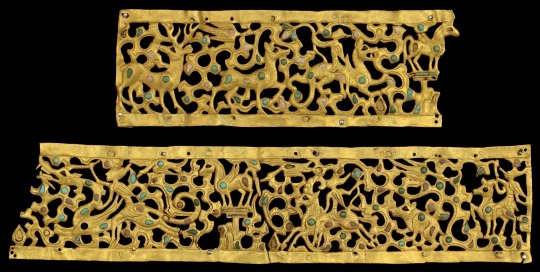
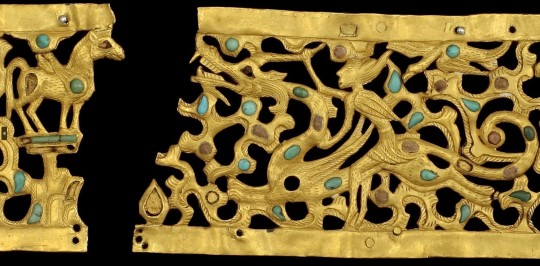
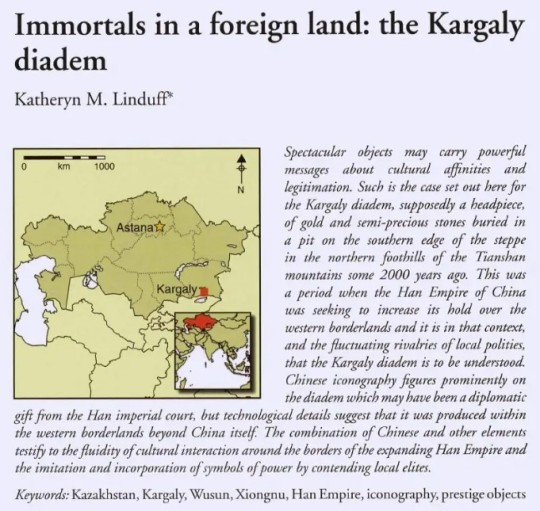
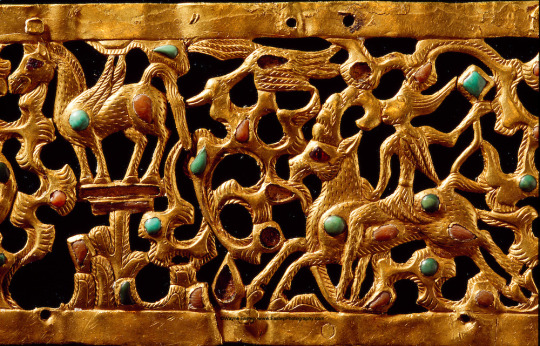
The Kargaly/Wusun diadem 2nd C. BCE - 2nd C. CE. Note, Katheryn's article below is much longer and has more info, I just took snips of what I found most interesting. It can be found online.
"According to Chinese archaeologists, the excavated skeletal remains presumed to be Wusun are of the short-headed Europoid Central Asian interfluvial type (Mallory Mair 2000: 93-94). On the basis of six skulls from the last centuries BC/first centuries AD found in Semirechye and presumed to be those of the Wusun, Soviet archaeologists have described them as ranging from primarily Europoid with some Mongoloid admixture to pure Europeans (Mallory Mair 2000: 93-94). Evidence from ancient Chinese texts is contradictory about the appearance of these peoples and only DNA and other types of scientific testing will bring clarity to this issue.
Although gold artefacts and inlay can be found dating from the Late Neolithic through to the Bronze Age in China, it was most prevalent in its borderlands (Bunker 1993: 27-46) until the Qin and Han, when it found preference on a broader scale.
In addition, the lost-wax lost-textile casting technology was developed and used (Bunker 1988: 222-27) in the area adjacent to the very tombs from where the iconography and style of the diadem hails. Observations about the inlay technology used on the diadem are important clues as well. Inlay appeared on Chinese-produced objects almost exclusively where a cell was created into which the stone was placed and adhered with some fixative (Bunker 1993). This is not the technique used to produce the diadem, where the gold was hammered into a matrix-template, then engraved (or chased) on the surface. Many of the cells for inlay were created in the hammering process and after the stones were in place, secured by hammering the bezels surrounding each stone. In addition, there were pierced cells filled from behind with stone and secured with the addition of a gold sheet adhered behind the stone. Items produced using such techniques would probably not have been created in Chinese foundries.
Moreover, gold animal plaques known from earlier Xiongnu tombs (third century BC) use inlay to enhance the natural conformation of the beasts (Figure 5). By placing inlays at the points of movement such as at the haunches of quadrupeds or at the wing joints of birds, the potential of movement and thereby the power of these wild creatures is underscored. Inlays also mark such features as eyes. On the Kargaly diadem, however, circular inlays are used decoratively as a patterned design, still often at the haunches, but also throughout the clouds. They no longer emphasize the natural form or movement of the animals or the clouds, but create an overall pattern. This recommends a later date for the diadem, perhaps late first or second century AD.
But why would such models be used in south-eastern Kazakhstan at this time? This is a unique piece—its style and iconography were nor known before or after in the region. The models for the iconography were taken from types known near Han imperial military outposts in a place where the Chinese hoped their troops could contain barbarian incursions and where peace and stability were difficult to maintain. Those units often included conscripts whose allegiance was opportunistic. The models for diadems (Stark 2012: 134) or for applications to adorn carts or clothing come from further west.
So, was this piece made in the Western Regions, in the territory beyond the Jade Gate of the Great Wall (in present day Gansu) that marked the boundary of Han hegemony, and then carried west? Was it perhaps made as a gift for an embassy to present to a Wusun or Yuezhi leader far outside of Han territory, such as in Wusun? Or, alternatively, was it carried by a regional princess to her place of exile and burial as the partner of one of those 'foreign' leaders?"
-Katheryn Linduff, Immortals in a foreign land: the Kargaly diadem. 2014, Antiquity, Vol 88, issue 339
#wusun#indo european#indo european mythology#chinese mythology#chinese#artifacts and antiquity#dragons#archaeology#anthropology#history#ancient history#ancient art#art#museums
236 notes
·
View notes
Text
Dyeus- Sky Father
Dheghom- Earth Mother
Perkwunos- Lightning bolt God
Neptonos- Ocean, Water, Sea God
Suhul- Sun God
Mehnot- Moon
Pushan- Nature
Hausos- Dawn Goddess
The divine twins
God of the Underworld
Beings of Fate:
The giant serpent:
#indo european#mythology#indo european mythology#comparative mythology#gods and goddesses#germanic tribes#history#linguistics
6 notes
·
View notes
Text
About the Development of Myths
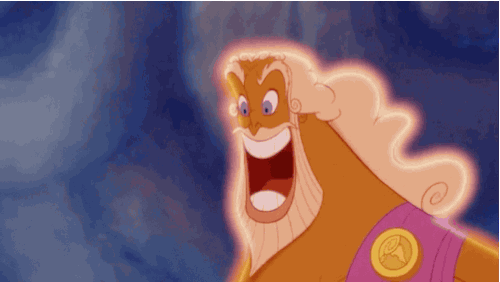
Okay, I will talk about more of the specific gods tomorrow again (starting first with the other gods from Stray Gods and then just looking over a variety of gods - I might start just with the greeks and then... venture into other mythologies). But first let me talk about the entire basis of what I have been talking about so far with the origins of Pan and Persephone: Their mythology is not a fixed thing.
Something that I would say education in general really fails on is properly expressing the amount of changes that cultures go through. I wrote about this before just in terms of history: There is not THE middle ages, not THE ancient Egypt, not THE ancient Greece and so on. All of those historical periods lasted for at least a thousand years. Now imagine that in like 500 years someone goes and looks at the 20th and 21st century as: "The World War and Globalisation period". Which I think there is a good chance this will at some point be known at (assuming we do not manage to eradicate our species before that, that is). Yet, you and I both know that if we were talking to someone from 1923 there would be very little we had in common.
Sure, this effect got massively accelerated thanks to the internet. But... You gotta have to assume that the Roman dude from 100 BC would also live in a very different world from the Roman dude of 200 BC. Because a hundred years is always going to involve a lot of change.
The reason we look at those old cultures as unchanging is, that they do not change anymore. And everyone who is neither working with that kinda stuff, nor is a complete geek, will just look at that culture as ONE FIRM THING rather than something fluent.
This is also true in terms of religion and related traditions, though we in the west are even more prone to it than other cultures. Because we do assume Christianity as this one thing. And the bible as this one unchanging thing. Hence the core believe is the same and, so the reasoning goes, was always the same. In fact, if you went to a religious school it is kinda how you were taught. The bible is one thing and always was the same thing. Only... It wasn't and even the basic we hve now does not matter.
Just look at the many Christian subreligions. They all in some way or form believe in Jesus, the one big God and all of that - but what they take from that widely differs. And the bible really does not have a big impact onto what ideals they hold and how they hold mass and how they pray and what not. If you think about it, you will easily see that, right? And if you just look a bit into what you might have learned about history in relation to Christianity, you will also know that this has changed. The role of Jesus has changed. How much the Holy Spirit is looked upon as an active actor. Which saints get venerated. All of that has changed a lot in just the last 50 years. And has changed a ton between the different countries.
And what I now need you to keep in mind that this was the exact same with the Ancient Gods and the religion attached to them. That holds true for the Greek Gods, the Roman Gods, the Egyptian Gods, the Norse Gods... all of them. The way they were worshipped changed over those thousand(s of) years they were worshipped.
So, let me once again talk about the Proto-Indo-European culture. Which is always a doosy and I love it.
The Proto-Indo-Europeans originates probably in the areas of modern day Ukraine and/or Romania and/or southern Russia some time around 5000 BC (scholars argue a bit about the exact temporal placement, just that it was somewhere between 7000 BC and 4000 BC). We do not really know a lot about them, because they did not write stuff down. But we do know that they had horses, were patriarchal, and that they worshipped a polytheistic pantheon that at least involved a Sky Father as one of the highest gods, who controlled the weather and was especially associated with storms and lightning.
These Proto-Indo-Europeans started breaking apart and travelling. Some into Asia, some into Europe and the Arabian/Persian areas. They brought with them their language and religion.
Now, it should be noted that they were not the "original humans" or anything. And that whereever they went... in most areas there were already other people living there, with whom they intermingled. Also whatever land they ended up settling was different, had different environments and this was included into their religious practice. Which made their religion over the years differ bit by bit. So from their pantheon sprang a lot of the pantheons we know today.
But... again, a lot of places they settled had already people living there. Who had their own worship. And that stuff often was also included and merged. Sometimes those other worships were very far reaching, sometimes very local. But some of those deities were picked up and either made part of whatever pantheon was there to come or was merged with an already existing god. And this happened again and again during the time that whatever pantheon was prayed to.
How do we know that, if it was not written down?
Well, mostly due to some archeology, but mostly due to comparative mythology and comparative linguistics. Two fields of science that basically involve people going over a lot of languages or mythologies (which, by the way, at times also includes fairytales and other oral narratives that are not necessarily held as "true", but still told) and basically finding things the reoccur. As well as going back over whatever written stuff we do have and noticing the shifts happening between a text written in 600 BC and a text written in 200 BC.
Now, for all the stuff we have two things that help a lot: a) The old Hindi writings and b) the written stuff from Egypt. Because both go really far back and were very well documented in writing. So basically we always can compare stuff to that and see shifts more clearly.
But, yeah... Technically all the pantheons are very much related. At some point Zeus, Jupiter, Diespiter, Thor, Tinia and Tian originated from the same character. You can even kinda see it in how similar the names are. Susanoo in Shinto-Mythology probably came from this, too, at least in the iteration we actually know about. (There can be some arguments made that a lot of the Shinto gods were shifted through the Buddhist contact, as the original indigenous Japanese cultures were very likely not Indo-European in origin. But given that the Ainu are the only culture whose oral tradition managed to survive this long, while the others either vanished or merged in a way influenced by Buddhism, which comes from Indo-European culture... yeah, it is there now.)
So, what I am saying: Mythology is shifting and always has been shifting. Same goes with religion. Hence the evolution of the Greek Pantheon.
Fun fact: Through comparative mythology we can also find the origins of YHW, the Abrahamitic god. Or God, as you might know him. He is a fascinating one, as he probably started out as a local god associated with harvest and weather in Southern Egypt and was then picked up by the Semitic cultures. He got a more pronounced role in the Canaanite pantheon, where at some point he merged with Baal, the war god. And through some trials and tribulations he finally ended up merging with El(hoim), the top god of the pantheon, with a part of the Canaanites splitting from the culture and developing into what would become the Jewish culture.
Super fascinating stuff. I love it.
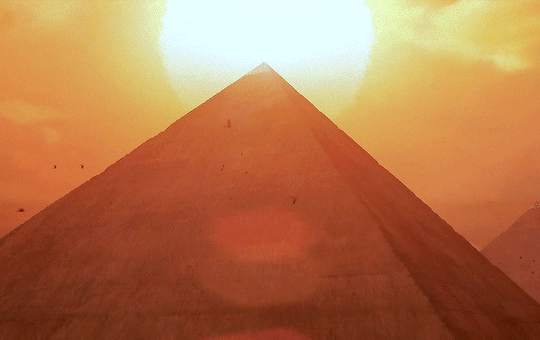
#stray gods#hades#history#mythology#proto indo european#early history#neolithic#ancient greece#ancient rome#ancient egypt#greek mythology#christian mythology#egyptian mythology
158 notes
·
View notes
Text

"If you have ever come upon a grove that is thick with ancient trees rising far above the usual height and blocking the view of the sky with their cover of intertwining branches, the loftiness of the forest, the seclusion of the spot, and your wonder at the unbroken shade in the midst of open space will create in you the feeling of a divine presence".
-Seneca the Younger on the numina.
#Seneca the younger#seneca#Lucilius#numina#numen#spirits#roman religion#nature#europe#tradition#indo-europeans#etruscan#julius evola#mircea eliade#mythology#myth#mos maiorum#Rome#jupiter#juno#minerva#divine presence#God
69 notes
·
View notes
Text
#norse gods#aesir#gods#viking mythology#scandinavian mythology#norse mythology#norse pagan#norse paganism#norse pantheon#norse polytheism#vikings#paganism#old norse#asatru#loki#eddas#prose edda#poetic edda#mythology#indo european#mythology poll#tumblr polls
15 notes
·
View notes
Text

The Dagda
#celtic#pagan#irish#paganism#witch#scottish#celtic mythology#fantasy#art#pagan art#ireland#scotland#european#tradition#indo european#traditional#drawing#sketch#europe#heathen#polytheism#god#the gods
139 notes
·
View notes
Text
Daily French Etymology #56
Autochtone (native)
Autochtone came from the Ancient Greek autókhthōn, meaning indigenous or native. It was derived from auto-, meaning self, and khthṓn, meaning earth or soil, thus it literally translates to 'spring from the earth'. Khthṓn came from the Proto-Hellenic *kʰtʰṓn, from the PIE root *dʰéǵʰōm, meaning earth or human.
Derived from this same root is the English word chthonic, which means living under or inside the earth, especially deities from ancient mythologies, such as Hades and the Furies in Greek mythology.
#linguistics#etymology#lingblr#root word#proto indo european#french#langblr#ancient greek#greek mythology
91 notes
·
View notes
Note
Hey, since Kur in "our" universe looks like a giant, iridescent, black serpent with a mane of flaming feathers and antlers (amazing design you came up with, btw), and since the Monday universe takes the normal character designs and skews it a bit to the left (Monday-Fisk has horns, Monday-Zak had his hair colors swapped, etc), what would your Monday-Kur look like?
Actually, I believe Monday!Kur would be a jaguar!
The Smoke Mirror is based on the Aztec myth of the 5 suns, which states that the world has been created and destroyed four times already. Each world is defined by which god acted as the sun; the first sun was Tetzcatlipoca, who - maybe because he lost his leg in an earlier myth - did kind of a crappy job. His sun was dim and black.(We know it’s specifically this myth because the game is “beasts of the fifth sun”)
The Smoke Mirror in the show is explicitly found in a temple dedicated to Tetzcatlipoca, and furthermore, one of Tetz'z epithets was The Smoking Mirror, as mirrors in Aztec times were made of obsidian, which is one of the things associated with Tetz. FURTHERfurthermore, Jay Stephens was active on forums around the time of the show's airing, and he confirmed that the Monday universe is not a MIRROR dimension (as in, Monday!Argost would not be a good guy), but rather, a DARKER dimension. It's kept deliberately vague whether the Smoke Mirror LITERALLY leads to an earlier version of the universe, or whether the mirror ALREADY led to a dark and twisted universe and the Aztec five suns myth sprang up around it.
Now, the reason why this means Monday!Kur is a jaguar to me is because Tetzcatlipoca was traditionally BITTER RIVALS with Quetzalcoatl. Quetzalcoatl is a big snake, and Kur is a big snake. (For the record, Quetz was the second sun in the five suns myth, and also the reason Tetz's world ended. In retaliation, Tetz ended Quetz's stint as sun. Now some other guy is the sun and these two are just Around).
Tetzcatlipoca is associated with, and sometimes takes the guise of, a jaguar. Hence, if "our" universe venerates Quetzalcoatl (and he is considered a folk hero), and "our" Kur is a big snake, then it makes sense to me for the Mondays' Kur to be aligned with Tetzcatlipoca, and to therefore be a jaguar.
(And in case you need context on Kur being a big snake - at the time the show was created, the Sumerian word "Kur" was believed to refer to a massive serpent that lived in the Netherworld (think the Greek underworld), therefore making it the first-ever recorded dragon in all of human history. This has since been debunked, as it turns out "kur" is kind of a multi-purpose word meaning - among other things - "mountain," "land," and "netherworld."
THAT ALL BEING SAID, there is actually a very interesting thing in Indo-European mythology, where there's a recurring theme of massive cthonic (of the underworld) serpents being slayed by storm gods. Tiamat and Marduk, Jormungandr and Thor, Yamato-no-Orochi and Susanoo, Typhon and Zeus... the list goes on. This points to all these stories having some sort of shared common ancestor (which we have not yet pinned down), and this idea of the quintessential massive cthonic serpent, father of all monsters, directly opposing the gods, embodying primal forces of chaos, is what Kur in the show is based on even if we now know that the WORD "kur" does not refer to one of these serpents. Neat, right?
Also, the show constantly associates Kur with the Hindu god Shiva, if you want some more symbolism to add to the pile. Kur's Tomb is listed in the Field Guide as the Koh Ker archaeological site, which is a temple in Cambodia dedicated to Shiva, whose remoteness meant it was excluded from remodels other temples in the area got when the religion changed. Also, one of Shiva's epithets is "The Destroyer," which Rani Nagi calls Kur when she's drowning Zak. Also, one of his symbols is a cobra (which happens to be a naga) around his neck, which represents Shiva's position as Lord of the Beasts, and Rani Nagi communicates through cobras. Also, the "divining rod" Fisk's lemurian instincts cause him to create is actually Shiva's trident, which represents trinities, like past/present/future, or creation/preservation/destruction. Just some fun trivia for you that you didn't ask for.)
#the secret saturdays#originally wasn't going to tag that#but then I went on a massive tangent explaining some of the show's most important#but also easiest to miss#symbolism and stuff#hey everyone get a load of this nerd here#doing extraneous research on proto-indo-european mythology#so that you don't have to#(please get a load of it)#(i want people to know how much damn research went into this show)
39 notes
·
View notes
Text
Blackcrowing's Book Review Masterpost

Irish Paganism: Reconstructing Irish Polytheism, Morgan Daimler
The Book of the Great Queen, Morpheus Ravenna
The Druids, Peter Berresford Ellis
The Horse, the Wheel and Language, David W Anthony
Celtic Cosmology and the Otherworld, Sharon Paice MacLeod
The History of the Vikings: Children of Ash and Elm, Neil Price
A Practical Guide to Pagan Priesthood, Lora O'Brien
God Against the Gods, Jonathan Kirsch
A History of Pagan Europe, Prudence Jones & Nigel Pennick
A Guide to Ogam Divination, Marissa Hegarty
Polytheistic Monasticism, Jann Munin
Ireland's Immortals, Mark Williams
A Circle of Stones, Erynn Rowan Laurie
This is a growing list that will be added to as new reviews are made
#book review#books#book#resources#masterpost#masterlist#blackcrowing#paganism#pagan#polytheism#celtic mythology#celtic paganism#celtic polytheism#norse mythology#Norse Paganism#norse polytheism#indo european#proto indo european#history#linguistics
36 notes
·
View notes
Text
Indo-European structure of the Baltic pantheon hinges heavily on a correct appreciation and interpretation of Patollus-Pecullus. Christian demonology found him exploitable yet did not quite know what to do with him. He was a demon of the underworld and leader of the host of the dead in the skies, hellish and aerial at the same time. This hesitation helps piece together his original nature. He has a Lithuanian allonym Velinas (Velnias, Vels, nowadays 'devil'), which is cognate with veles 'ghosts' and with the ancestral goddess Veliuona; Szyrwid's dictionary of 1629 already equates Velnias with 'Piktis'. In Lithuanian folklore Velinas is the one-eyed, prophetic, treacherous, raging god of the veles who fight, hunt, and march in the skies; he is also the lord of hanging and the hanged. This dossier is ample to permit a typological comparison with both the one-eyed Hangagud Odin and the Old German Wutanes her. Beneath the death-god described by Simon Grunau and revived by Gunter Grass and the devil of demonology and folklore, we find a principal figure of the Baltic pantheon, whose name Pecullus has the same "rage" meaning that inheres in Odin, and whose parallel name Velinas is best connected with Old Norse valr, denoting the host of the slain. The presence of such a magical, death-oriented high god in close complementarity with the ruling thunder-god seems to be typical of several contiguous nothern European subgroups (cf: Odin : Thor and perhaps Esus : Taranis); Patollo's white headcloth may indeed be the missing link connecting Odin's floppy hat with Rudra's turban in India.
Comparative Mythology. Jaan Puhvel.
13 notes
·
View notes
Text
*Deh₂nu
*Deh₂nu- is a hypothetical goddess of water in Proto-Indo-European mythology, with connections to the names of rivers like the Danube, Don, Dnieper, and Dniester, as well as the Vedic deity Dānu, the Irish Danu, and the Welsh Dôn. Despite acknowledging a possible lexical connection, Mallory and Adams contend that there is not enough evidence to support the idea that a distinct river goddess existed in Proto-Indo-European beliefs. They primarily highlight the Indic tradition's understanding of river deification. Furthermore, Mallory and Adams suggest that a theory for a sea god called *Trih₂tōn—whose name is derived from the Greek Triton and the Old Irish word for sea, trïath—is unsupported by the lack of a corresponding sea god in Irish mythology and only minor lexical similarities. The Ossetian god Donbettyr is also mentioned in the story. Who is placated by gifts to keep the waterwheel turning, and who Donnán of Eigg proposes as a Christian equivilent of this figure.
Moreover, this deity and the Dan river in Centeral Asia may have similar etymologies.
She is frequently seen as the mother of a mythical tribe, the *Deh₂newyóes, in many Indo-European cultures; these tribes are deduced from the Vedic Danavas, the Irish Tuatha Dé Danann, the Greek Danaoi, and the Norse Danes. Under Bel's leadership, this tribe is said to have fought a hero called *H₂nḗrtos, which could connect them to characters like the Norse god Njord, the Nart from the Nart saga, and Indra's epithet nrtama.
#Irish#Vedic#Norse#Nart#Mallory#Irish Danu#Welsh Dôn#Irish mythology#hypothetical goddess#Proto-Indo-European#Welsh#Adams#Indic#Greek#Old Irish#Ossetian#Christian#Dan#Central Asia#Indo-European#Vedic Danavas#Tuatha Dé Danann#Danaoi#Bel#deity#sea#river#Norse Danes#tribe#druidicentropy
4 notes
·
View notes
Text
Tried to repost on tumblr but the damn site wouldn't allow me.
#lusitanians#lusitanian#lusitanian mythology#iberian mythology#iberian peninsula#portugal#pagan#paganism#indo european#history#mythology#worldbuilding
6 notes
·
View notes
Text
Roman Gods ≠ Greek Gods

Okay, given that Stray Gods has kinda pulled me into that Mythology thing again... Let me quickly say something: No, the Roman Gods are not just the Greek Gods.
A lot of media - like A LOT - acts as if the Roman Gods are just basically the Greek Gods with some minor changes. But, like... They are not. And acting as if they were is simply misunderstanding how religions and thier mythologies work.
If you were to look at it like this, you could argue that YHW is Zeus and is Susanoo as well, if we are on that. (Alright, last one is a topic we gotta argue about.) Because here is the thing: All European and a good chunk of Asian and some North African cultures came from or were influenced by the Indo-Europeans. Aka, some folks who lived some more than 6000 years ago, who were a big influence in making horses a thing and promptly used those horses to spread over the previously mentioned areas. With them they brought their languages and their mythology. Both things that shifted over hundreds of years, creating on one hand the different languages - as well as the different mythologies.
Greek, Roman, Egyptian and Norse mythologies are part of that. As is the Semitic mythology - which obviously birthed Judaism, Christianity and Islam.
The gods did not originate with the Greeks. They were much older than that. We even know from where some of the Greek gods came, as we have fragments documenting them being worshiped by some pre-greek cultures.
Which is kinda where the entire thing with the Greeks and Romans comes in. The incorporation of the Greek gods to the Roman religion seems so obvious to us, because it is so well documented. Because both cultures wrote down a lot of stuff, which gave historians the amazing ability to understand a lot more about their culture and religion - because they could read all of it. It is not like with the Norse or the Celtic mythology where the people in question only transmitted those stories orally, making it so that the first to write those stories down were people who did not actually believe in them/practiced the religion and wrote them down from a more or less outsiders perspective. So, we know a lot of those gods and we can very clearly see that the Romans adapted a lot from the Greeks.
But... here is the thing: Not only they adapted them, but quite a few gods were also fused with deities local to Rome and what is modern day Italy. Both things were merged - and there are in fact some gods in which the Italic version of them is more influencial than the Greek one.
Obviously, the Italic people were also from Indo-European roots, so yeah, it probably made sense to merge Zeus and Diespiter, who both were "sky fathers" into one deity.
Yes, there was a whole political aspect in taking over the pantheon.
But saying "Oh, yeah, they just painted over the names" is just ignorant of the cultural context.
#rant post#greek mythology#roman mythology#ancient greece#ancient rome#indo european#history#ancient history#mythology#hades#stray gods#rick riordan
122 notes
·
View notes
Photo

“Apart from what separates them (which is not negligible), [European nations] are heirs of a common cultural matrix, which is at least five thousand years old".
- Alain de Benoist.
#europe#indo-european#alain de benoist#zeus#European myths#European symbols#traditionalism#rape of europe#sidon#bull#crete#poseidon#jupiter#Sodonia#kidnapping of europe#rubens#goya#phoenicians#greek mythology#minos#Astarte#heracles#minotaur#herodotus
53 notes
·
View notes
Text
Fulla and Pollux
If the name of Norse goddess Fulla indeed means ‘bountiful’, as is thought, then it comes from the same root as the name of the Greco‐Roman god Pollux.
2 notes
·
View notes